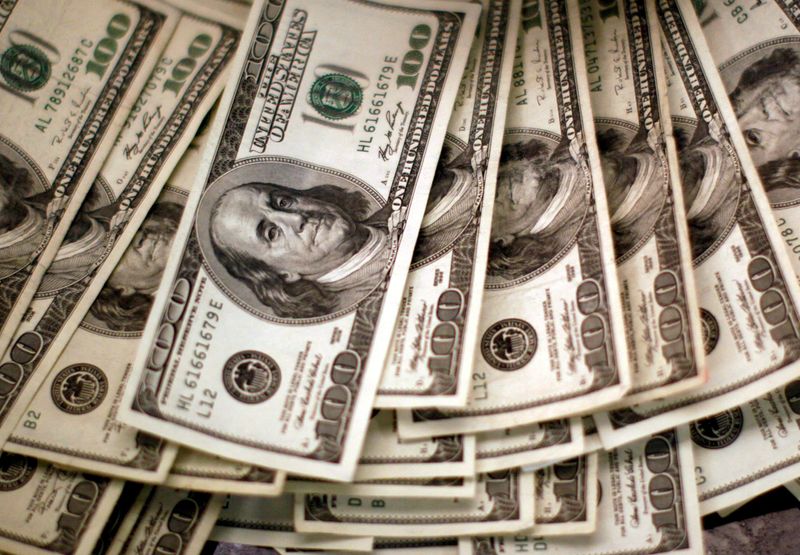By Jamie McGeever
ORLANDO, Florida (Reuters) -The ‘dollar smile’ could be a blessing for Wall Street, or a curse.
Right now, with the dollar’s boom driven by a destabilizing rise in US bond yields, increased uncertainty about global growth and rapidly deteriorating investor sentiment, it is certainly the latter.
The gist of the “dollar smile” theory, put forward twenty years ago by currency analyst and now hedge fund manager Stephen Jen, is this: the dollar tends to appreciate in good times (rising investor confidence and roaring markets) and in bad times (times of major financial problems). stress and ‘risk off’ markets), but falls somewhere in between.
The outperformance of the U.S. economy amid a solid global expansion that is attracting strong inflows of investment into U.S. assets, and government bond yields that are higher than those of their international peers are a recipe for a strong dollar and a powerful Wall Street.
The conditions that have fueled the dollar’s rapid rise since July could not be more different.
Chinese, European and many emerging economies are creaking, fears are growing that aggressive Fed policy will “break” something at home, and the explosion in real interest rates has shrouded Wall Street – especially growth and technology stocks – in a mushroom cloud of worry . and uncertainty.
In terms of the ‘dollar smile’, these are ‘bad’ times. There is growing sentiment in the markets that the negative relationship between US equities, the dollar and interest rates could continue for months to come.
“I expect rates to remain negative for the foreseeable future, which is the next three to six months,” said Stuart Kaiser, head of U.S. equity trading strategy at Citi. “This is a high-risk environment.”
Kaiser estimates that yields have fallen about 7.5% over the past two months. The dollar was responsible for 3.3 percentage points of that and the 10-year real rate 2.1 percentage points, which he said are by far the two biggest contributors.
The dollar has risen about 7% since mid-July and is on track to post an eleventh straight weekly gain. That would mark a record gain since the era of free-floating currencies began more than fifty years ago.
There have been periods of stronger appreciation, such as the early 1980s and 2014-2015, but never a more consistent increase. And with US Treasury yields at their highest in years and still higher than the rest of the world, it may not be over yet.
FINANCIAL CONDITIONS ARE CONSIDERED
A stronger dollar and rising bond yields, especially inflation-adjusted ‘real yields’, in a ‘risk off’ investment environment could scare the horses on Wall Street and potentially fuel a self-fulfilling spiral of selling and de-risking.
There is no evidence that stocks are about to crash. But the speed and magnitude of the dollar and government bond movements, and the tightening of financial conditions, warrant vigilance.
According to Goldman Sachs, financial conditions in the US are the tightest this year. This is no different from other major economies and regions, some of which – the eurozone, China and emerging markets – are feeling even greater pressure.
The bank’s U.S. Financial Conditions Index (FCI) has risen 95 basis points since mid-July and the breakdown shows how the dollar, rates and stocks are reinforcing each other.
Compare that to the 100 basis point rise in the global FCI or the 145 basis point rise in the emerging markets FCI from their July 25 low, which were driven almost entirely by higher short and long-term interest rates. The impact of exchange rates, positive or negative, was negligible.
As Rabobank’s Jane Foley notes, the dollar’s historical inverse correlation with emerging market equities – a decent barometer of risk appetite – is ‘fairly’ strong.
“This suggests the dollar will find support on safe-haven demand even as the U.S. economy slows,” Foley wrote Thursday.
If this dynamic intensifies and momentum gains momentum, the dollar’s strong exchange rate could also begin to erode the dollar value of U.S. companies’ foreign earnings, potentially having a material impact on corporate profits.
It may be too early to show that in the third quarter results – many big Wall Street firms will have hedged their currency exposure in the short term – but if gains continue, fourth quarter earnings could be negative being influenced.
There could be less concern in corporate America, especially in the growth-sensitive and technology sectors that led the rally in the first half of the year, if the dollar’s surge occurred in a relatively stable fixed-income environment.

But nominal and inflation-adjusted yields on long-term bonds have skyrocketed, threatening future cash flows and profits. Another reason for investors to be cautious.
(The views expressed here are those of the author, a columnist for Reuters.)
(by Jamie McGeever; editing by Andrea Ricci)


